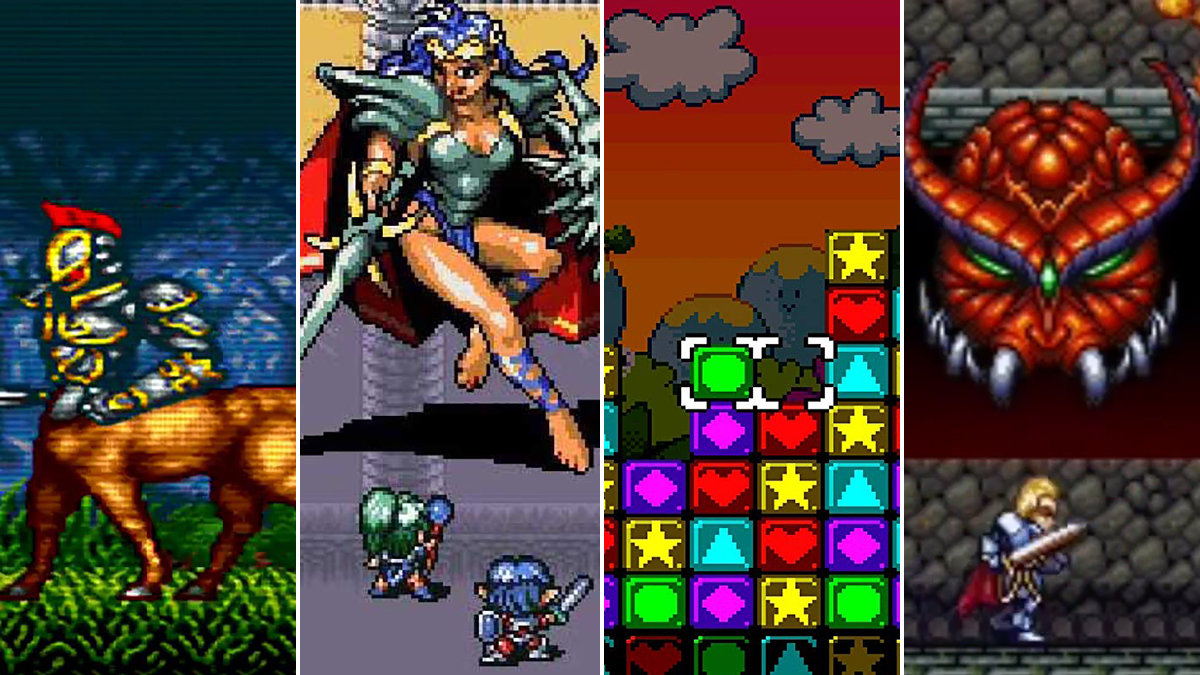
Even though the Big N has released five more consoles since the Super Nintendo, many Nintendo fans would say the SNES is still the best console that the House of Mario has ever released.
Much of the console’s success has to do with its roster of games, of course. From third-party titles to Nintendo’s own franchises, this was an era—from 1990 to 1996—that showcased the platform’s total dominance over the industry, even as the Sega Genesis proved to be a strong competitor—and we all know who won that console arms race in the end. It’s not difficult to see why: Super Mario World, Super Metroid, and The Legend of Zelda: A Link to the Past are the very best games in their respective series. And that’s not even counting games made by outside studios, such as Capcom and Konami.
There’s a lot more to the SNES library than just Mario, Samus, and Link, and more than two decades later, many of these games are still criminally overlooked. These are the 35 most underrated games on the SNES.
*Note: This article has been updated since it was originally published to include entries 35-26
35. E.V.O.: Search for Eden
1993 │ Almanic
Imagine a video game where you control a small creature, use it to battle other creatures, and evolve it into stronger forms after gaining enough EXP. No, I’m not talking about Pokémon but a game that was released several years before it.
E.V.O.: Search for Eden was a platformer RPG where players only had one goal: Survive. To do this, players have to bite, bash, and bludgeon their way past hostile creatures, and every victory net evolution points. Earn enough, and a creature could add or upgrade a body part that (usually) improved its capabilities. The number of combinations players could create was nearly endless, and the game encouraged experimentation through secret evolution paths. While E.V.O. was fairly grindy and repetitive, it’s worth playing just to see what kinds of patchwork chimera you can create. – Aaron Greenbaum
34. The Lost Vikings
1993 │ Silicon & Synapse
Blizzard Entertainment is synonymous with titles such as Warcraft, Diablo, and StarCraft. But before Blizzard made those games (or was even known as “Blizzard Entertainment”), the company was better known for titles like The Lost Vikings.
The Lost Vikings was a comedic puzzle platformer where players controlled the three titular lost vikings: Erik the Swift, Baleog the Fierce, and Olaf the Stout. Each character had its own special abilities, and gamers had to use all three if they wanted to beat a level. While difficulty ramped up quickly in The Lost Vikings, players had unlimited continues, so they could keep trying over again as long as they wanted. The sequel, The Lost Vikings 2, was more of the same but with additional abilities and characters. Either title is worth your time if you can find it. – AG
33. True Lies
1994 | Beam Software
Though the SNES was the home of a surprising number of surprisingly good games based on movies and TV shows, many of those titles went cruelly overlooked due to the bad taste that the worst games in that category left in our mouths. Though quite a few of those games were unsurprisingly based on Arnold Schwarzenegger movies, True Lies gave our greatest action hero the video game experience he always deserved to star in.
True Lies is an overhead shooter that initially resembles something like Smash TV but is actually a little deeper than that. It certainly lets you shoot your way through waves of bad guys in surprisingly gory fashion, but the real star of the show is True Lies’ surprisingly engaging objectives and more labyrinthian levels. It’s honestly closer to a SNES version of Hotline Miami in some ways. Granted, its action isn’t nearly as refined as what you’ll find in the best Konami and Capcom titles of the era, but it’s a more than worthwhile experience in its own right. – Matthew Byrd
32. Clock Tower
1995 | Human Entertainment
Though there are a few games on the SNES that boast great horror themes, Clock Tower is really the only SNES game I’d bother to call “scary.” Actually, this game’s genuinely scary nature and more methodical gameplay were likely two of the bigger reasons why it didn’t find much of an audience in 1995. By the time Resident Evil came along the next year, Clock Tower already felt like a historical footnote.
While Clock Tower certainly shows its age these days, it remains a remarkably intriguing horror gaming experience. Built around a stalker system that sees protagonist Jennifer Simpson constantly try to escape the appropriately named Scissorman, Clock Tower maintains a welcome sense of dread that is bolstered by the game’s incredible gothic atmosphere. This game didn’t have all the answers, but it was certainly asking all the right questions. – MB
31. Breath of Fire 2
1995 │ Capcom
While Squaresoft dominated the SNES JRPG scene with Final Fantasy, more than a few solid contenders popped up here and there, one of which was Capcom’s Breath of Fire. This RPG impressed audiences with its large world, memorable characters, and iconic dragon transformation system. But there’s always room for improvement.
Barely a year after Breath of Fire’s launch, Capcom released Breath of Fire 2, which improved virtually every aspect of gameplay. Graphics pushed the limits of the SNES’ pixel fidelity, the story received much more attention, and combat was more tactical thanks to the addition of party formations. And, if you will pardon the pun, the soundtrack of Breath of Fire 2 was absolute fire in the best ways possible. It’s a shame Capcom has all but abandoned turn-based RPGs because we sure could do with a Breath of Fire resurrection. – AG
30. Magic Sword
1990 | Capcom
On the surface, Magic Sword should be significantly more popular than it actually is. A SNES action game made by Capcom with innovative mechanics, 50+ levels, and alternate endings? Why don’t we all know about this? Well, the truth of the matter is that this game’s visuals, animations, and sound didn’t quite survive the transition from arcade to SNES. On the surface, it’s a pretty rough experience.
The gameplay is sublime, though. Bolstered by an incredible partner system that lets you bring one of several companions into battle, Magic Sword falls somewhere between a beat-em-up and a Contra-like side-scroller. Its action is satisfying, its difficulty is surprisingly well-tuned, and for a game with this many levels, it features a surprising variety of enemies, backdrops, and themes. It’s not an all-time classic, but it’s a fantastic time. – MB
29. Demon’s Crest
1994 │ Capcom
Before Capcom became synonymous with the survival horror of Resident Evil, it was known as the company behind the hand-blisteringly difficult Ghosts ‘n Goblins franchise. These games had many enemies, but none challenged and annoyed players quite like the demonic Firebrand. So Capcom’s developers thought to themselves, “Why not make him the star of his own game?”
Demon’s Crest is the third and most polished title to feature Firebrand (Gargoyle’s Quest and Gargoyle’s Quest II for the Game Boy and NES, respectively, are the first and second). Demon’s Crest is a Metroidvania platformer that revolves around the titular Demon Crests. The more players find, the more abilities they unlock that not only change combat but also open up new paths in old levels. Demon’s Crest is slower and more methodical than Ghosts ‘n Goblins, but it’s every bit as challenging. – AG
28. Brain Lord
1994 | Produce!
The SNES’ collection of APRGs is generally underrated. While JRPGs understandably dominated the scene at that time, the best of those ARPGs often feel novel and refreshing to this day. Brain Lord doesn’t quite crack the top tier of that genre, but it is an immensely entertaining experience that holds up remarkably well to this day.
Brain Lord focuses a bit more on the action side of the ARPG formula. Actually, it’s closer to a dungeon crawler or Zelda title in many respects. The game is constantly forcing you to navigate a surprisingly devious collection of puzzles and traps, though the satisfying combat and excellent dungeon designs keep things from becoming too frustrating too quickly. Brain Lord doesn’t break a lot of new ground, but it’s a fantastic ARPG for those who love this era of the genre and are looking for something geared towards a slightly more hardcore audience. – MB
27. U.N. Squadron
1991 │ Capcom
Usually, you can judge a video game by its box art since it helps convey what the game is all about. However, that isn’t always true. Every so often, a box provides the wrong message. The art for U.N. Squadron, for instance, makes it look like a boring flight sim. In reality, it’s anything but boring.
What gamers in the U.S. knew as U.N. Squadron was a side-scrolling shoot ‘em up originally called Area 88. Like many in its genre, U.N. Squadron was a fast and frantic shooter that threw plenty of enemies at players, but it set itself apart with variety and difficulty. Players could select different pilots, each with their own pros and cons, and upgrade their planes before each level. But most importantly, U.N. Squadron didn’t follow the stringent “get hit once, die and lose all your powerups” gameplay design of other shoot ‘em ups. Instead, it gave each plane a health bar, and players kept their weapons after death. As a result, the game was much more balanced and fair than your average shoot ‘em up without losing any of the spectacle or challenge. – AG
26. Super Adventure Island II
The Adventure Island games are fun, but many of them are just “solid-to-very-good” action platformers with a little extra style to spare. With Super Adventure Island 2, though, developer Make Software, Inc. decided to try something really different. In the process, they created a kind of SNES masterpiece that has rarely been replicated.
Super Adventure Island 2 incorporates RPG and exploration elements not seen in the other Adventure Island games. It features upgrades, shops, an overworld map, and even a surprisingly deep series of minigames highlighted by a casino that lets you bet on creature foot races. It’s that all-too-rare kind of game that uses fundamentally satisfying action platforming gameplay as the basis for a slightly deeper experience. It’s very likely your favorite SNES game you’ve never played. – MB
25. Saturday Night Slam Masters
1993 | Capcom
Wrestling games were extremely hit or miss in the 8-bit and 16-bit eras. You could argue that the WWE, really the only name in professional wrestling in the U.S., didn’t put out a single great game until the N64 era. That’s fine, though, because it gave other companies the opportunity to innovate with much more creative titles that focused on the over-the-top nature of sports entertainment. – Chris Freiberg
Saturday Night Slam Masters was one of those games, playing more like a traditional fighter that ends with pinning your opponent than a wrestling game. The art, which was created by Fist of the North Star artist Tetsuo Hara, almost made the game feel like a Street Fighter II wrestling game, which is not a bad thing at all. – Chris Freiberg
24. Ogre Battle: The March of the Black Queen
1993 | Quest
Ogre Battle is possibly the greatest unfinished saga in gaming. The very first game in the series appeared on the SNES and began with a tarot reading that determined your fitness for leading a revolution against an evil empire. And what a revolution it is, as you spend dozens of hours recruiting and building an army of soldiers, witches, and even griffins in a strategy game that still feels incredibly deep more than 20 years later.
The SNES version is one of the rarer titles on the console, but it’s since been re-released on the Wii Virtual Console. There’s also a quality PlayStation port that’s slightly cheaper, but still one of the higher priced games on that system. Regardless of which version you play, this is a game that all strategy and RPG fans need to experience at least once. – CF
23. Tetris Attack
1996 | Intelligent Systems
Nintendo seems content to re-release a barely updated version of Dr. Mario every few years but has completely ignored its best puzzle game of the ‘90s. Don’t mind the Tetris in the title, this is a completely new puzzle game where you match colored blocks as they rise from the bottom of the screen in an effort to keep them from reaching the top.
It’s all wrapped around a story involving Yoshi and Bowser, which is fine, but the real star here is the ultra-competitive two-player mode. It’s a real shame that Nintendo hasn’t yet released an HD version of this game with online multiplayer. – CF
22. Boogerman
1994 | Interplay
Because Mario and Sonic were such massive successes in the ‘90s, virtually every other publisher assumed that they too needed a mascot to put them on the map. This led to some…unusual creations, most of whom have thankfully been forgotten.
Boogerman is one of those characters that are maybe better left in the ‘90s (a 2013 Kickstarter to revive the franchise was a massive failure), but he actually starred in a pretty cool game. It had some of the better graphics and music of any platformer from the era, and while the ability to burp and fart on your enemies is incredibly sophomoric, it still entertains adult me almost as much as 10-year-old me. – CF
21. Goof Troop
1993 | Capcom
Goof Troop was a fairly forgettable Disney cartoon starring Mickey Mouse’s talking dog pal, but at least it gave us a surprisingly good Super Nintendo game. This was a time period when Capcom could do no wrong, and the company put Shinji Mikami, who would later go on to direct much of the Resident Evil series, in charge of Goof Troop.
Sadly, there are no zombies or gore, but there are some surprisingly strong survival elements, like having to defeat enemies with objects in the level rather than facing them head-on. If you’ve ever wanted to see where some very early Resident Evil ideas got their start, this is the game to check out. – CF
20. Weaponlord
1995 | Visual Concepts
Weaponlord is the definitive example of a game ahead of its time. While accessible fighting games like Mortal Kombat and Street Fighter ruled the roost in the mid-’90s, the team at Visual Concepts set out to create an extremely deep fighter focused on weapon combat, countering, and parrying. While Weaponlord featured only a few characters, they each had tons of special moves and “death combos” that put many of Mortal Kombat’s fatalities to shame. And which characters you killed during the story mode actually had an impact on the ending.
Despite these innovations, reviews were largely negative at the time of release. Still, the game’s reputation has improved quite a bit in recent years. Publisher Namco even used many of Weaponlord’s ideas in its Soul Edge and Soulcalibur games. – CF
19. Phalanx
1992 | Kemco
Phalanx might take the prize for worst box art on the SNES. Despite being a 2D shooter, it features a bearded old man playing banjo on the cover for some reason. There’s a space ship too, but most of the focus is on the old guy. Maybe there was a mix-up in the art department, and they didn’t have time to fix it. It’s not really clear what happened.
Anyway, those who got past the box actually found a surprisingly fun shooter. You could control the speed of your ship, store multiple weapons simultaneously, and even sacrifice these weapons for smart bombs. It’s not the deepest game on the SNES, but it is one of the most enjoyable in brief spurts. – CF
18. Indiana Jones’ Greatest Adventures
1994 | LucasArts
LucasArts’ Super Star Wars games still get a lot of love, but its lone Indiana Jones game on the SNES is arguably superior. The game takes you through all three Indy movies (let us never speak of the fourth one), as you take out baddies with Indy’s iconic bullwhip.
While primarily a platformer, there are also a few levels featuring flying, a mine cart, and even a raft traveling down a mountain. Sadly, there have only been a handful of Indiana Jones games released over the years. This one is easily one of the best. – CF
17. Uniracers
1994 | DMA Design
If you’ve never heard of DMA Design, they were a small Scottish developer that went on to develop a little series known as Grand Theft Auto. Uniracers has pretty much nothing to do with GTA. There are no open worlds, mob bosses, or murders.
Uniracers is just a relatively simple, family-friendly, incredibly fun game about racing unicycles and pulling off tricks with them. Certainly, no one would object to Nintendo resurrecting the series, or Rockstar including an homage to it in the next GTA. – CF
16. The Adventures of Batman & Robin
1994 | Konami
Batman: The Animated Series stands up as one of the greatest cartoons of all time, and the SNES game based on the show is the rare ‘90s licensed game to do its source material justice. The graphics and sound are outstanding for their time. This is a game that almost looks and sounds like the cartoon, which was almost unheard of back then.
All of the major Batman villains from the series are included as bosses, and you need to use a variety of bat-gadgets to take them out. The Batmobile stages are a little hard to control, but they’re worth putting up with because everything else is of such high quality. – CF
15. Lufia II: Rise of the Sinistrals
1996 | Neverland
In the ‘90s and early 2000s, many great games took longer than expected to develop, were released just as a new generation of consoles was on the horizon, and were completely forgotten until they were rediscovered by nostalgic fans years later. Lufia II is one such game.
Building on a good, but not great RPG released earlier in the SNES’s life cycle, Lufia II featured deeper puzzles and gameplay mixed with some of the best music on the console. Lufia II is easily one of the best RPGs of the ‘90s that Square had nothing to do with. – CF
14. Ys III: Wanderers from Ys
1991 | Nihon Falcom
Despite eight main entries released to date, and a surprising number of remakes, the Ys action-RPG series hasn’t really broken into mainstream gaming. While the earlier games in the series were strictly top-down, similar to the Legend of Zelda in many ways, Ys III was a more traditional side-scroller. Because of this, it’s often viewed as the dark sheep of the series, but that’s ignoring a surprisingly fun and epic game that can stand on its own as one of the better platformers on the console. – CF
13. The Legend of the Mystical Ninja
1992 | Konami
Goemon/Mystical Ninja is an absolutely hilarious and brilliant action-RPG series that is sadly so deeply-rooted in medieval Japanese culture that Konami has never quite figured out how to market it in the west. The Legend of the Mystical Ninja was the very first game in the series released in North America, and it’s an almost pitch-perfect beat ‘em up with strong RPG elements.
Much of the series’ trademark humor translated fairly well in this version, and it has a wonderful soundtrack inspired by traditional Japanese music. Sadly, Konami seems to have completely lost interest in the series in recent years. – CF
12. Mega Man Soccer
1994 | Sun L
Long before Mario made a name in the world of sports, Capcom tried to expand the Mega Man franchise with this bizarre soccer game. The gameplay is fairly standard for the time, with the addition of special attacks used by the robots in the main series of games. Somehow, this is actually a canon game that takes place after Mega Man 4.
In the game, Mega Man and Proto Man decide that the best way to stop Dr. Wily is a soccer match. While hardly the greatest game in the illustrious Mega Man series (or even the best soccer game on the SNES), it’s graphics and soundtrack hold up pretty well, and if nothing else, it’s worth checking out for the novelty of it. – CF
11. Jurassic Park
1993 | Ocean Software
The Jurassic Park movies have inspired some surprisingly good games over the years, beginning with the very first title released on the SNES to coincide with the original movie. Yes, you play as Dr. Alan Grant, and you fight dinosaurs with a bunch of weapons from a top-down perspective, which wasn’t terribly innovative for the time. But this is actually a much more thoughtful adaptation of the film than you would first expect. – CF
You can communicate via radio with other characters from the film. Some of the characters will even try to impede your progress with bad advice. And when you head indoors, the game shifts to a first-person view as you collect ID cards. This is so much better than the typical movie cash-in that flooded the SNES library in the mid-‘90s. – CF
10. Cybernator
1993 | NCS Corp
Cybernator proves yet again that there are few things more cathartic than manning a giant mech and shooting the hell out of other mechs and robots. The developers at NCS Corp seemed to take real joy in taking this generic concept and pushing it to its full potential, with tight controls, vibrant graphics, and even a surprisingly strong soundtrack. Cybernator remains somewhat obscure even today, but it’s well worth picking up if you run across a cartridge in the wild. – CF
9. Metal Warriors
1995 | LucasArts
And if you loved Cybernator, I’ve got great news for you because Metal Warriors is basically an unofficial sequel. While developed by a completely different company (the legendary LucasArts), Metal Warriors doubled down on everything that made Cybernator great, with more mechs, faster gameplay, and better graphics.
The game even featured the ability to exit your mech to get through certain areas. Some fans argue that Cybernator is the superior game, but Metal Warriors tweaked what made that game great just enough to edge out its unofficial predecessor. – CF
8. Super Smash TV
1992 | Williams
Basically a twin-stick shooter before consoles came with analog sticks, Super Smash TV featured incredibly fast and intense gameplay. This nearly perfect port of the arcade version lets one or two players blow off steam by firing weapons at hundreds of enemies attacking them from all sides as part of a futuristic life-or-death TV show. Well, the 1999 setting seemed futuristic at the time. – CF
7. Blackthorne
1994 | Blizzard Entertainment
Before Blizzard built mega huge franchises like StarCraft, Warcraft, and Diablo, there was simply Blackthorne. But even back in 1994, Blizzard seemed poised for greatness. What could have been another generic 16-bit shooter was actually a much deeper game, which required you search for keys in its giant, vibrant levels to progress. Even if you’ve never played the SNES version, Blackthorne is a free download on Battle.net now, so there’s no reason not to play it now. – CF
6. Zombies Ate My Neighbors
1993 | LucasArts
Back in the day, LucasArts was actually known for a lot more than cranking out Star Wars games and dysfunctional development cycles. The developer used to make really innovative games like Zombies Ate My Neighbors, a top-down shooter with tons of weapons, ranging from water guns to bazookas. And it had real personality, too.
Zombies contained nods to numerous classic horror movies, and despite the title, monsters included enemies like squidmen, blobs, and even giant demon babies. This is also one of the more difficult games of the 16-bit era, but it’s well worth experiencing just for the creativity on display alone. – CF
5. Actraiser
1991 | Quintent
Few games have ever pulled off the merging of two completely disparate genres into one like Actraiser did. Yes, much of the game is a solid, though not especially memorable platformer, but those sections are squeezed between a really interesting city-building section where you basically play God (in fact, you were referred to as “God” in the Japanese version).
Even though it seems like these two gameplay styles should have nothing to do with each other, it works remarkably well here. Actraiser is one of the finest, most memorable games on the SNES, and its sequel is worth checking out as well. – CF
4. Shadowrun
1993 | Beam Software
There was no shortage of traditional sword and sorcery RPGs on the SNES, so Shadowrun stands out specifically for its dark cyberpunk setting. While receiving mixed reviews upon release, Shadowrun’s image has been rehabilitated in recent years, with many players praising its deep conversation system and gameplay that mixes traditional table-top rules with 16-bit RPG action. Plus, the game’s film noir influences helps give it what’s quite possibly the best storyline of any SNES game. – CF
3. Illusion of Gaia
1994 | Quintent
Illusion of Gaia is an action-RPG for gamers who want something different from their action-RPGs. While combat remains relatively simple, there are so many new ideas that work surprisingly well, like an experience system that de-emphasizes grinding and a simplified item system.
Those might sound like bad ideas at first, but they work surprisingly well in the context of the game. Wrapped in some truly ingenious puzzles and one of the best stories of the 16-bit era, you’ll wonder why more games haven’t tried to copy Illusion of Gaia’s innovations. – CF
2. Secret of Evermore
1995 | Square Soft
Square released so many great SNES games in the ‘90s that at least one of them had to fall through the cracks. Secret of Evermore is unique among Square titles, as the only game ever released by the company that was designed by Americans. This meant a more westernized art style, and a focus on traditional tropes of American storytelling, like the adventure of a boy and his dog.
But you can also see a lot of the Square influence at play here too, with combat extremely similar to Secret of Mana (though the two titles are officially unrelated). Evermore may never quite meet the heights of Mana, but it’s still worth tracking down to see how a Square game would turn out with a stronger western influence. – CF
1. Harvest Moon
1997 | Amccus
On paper, Harvest Moon sounds like the worst game ever. You inherit a farm. You grow crops and take care of livestock. If you’re particularly successful, you get married, too. But anyone who has played a Harvest Moon game knows that while this sounds about as exciting as watching paint dry, it’s actually incredibly addicting watching your farm grow.
While later games in the series included much more customization, the SNES original is still one of the most relaxing games around, and well worth a playthrough for anyone looking for something a little bit simpler than saving the world. – CF
The post 35 Most Underrated SNES Games appeared first on Den of Geek.







